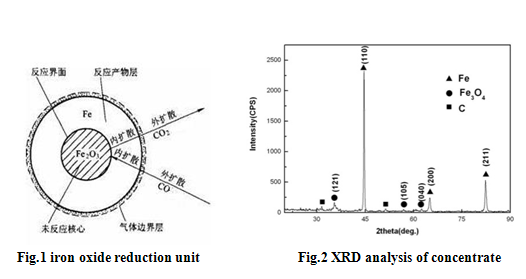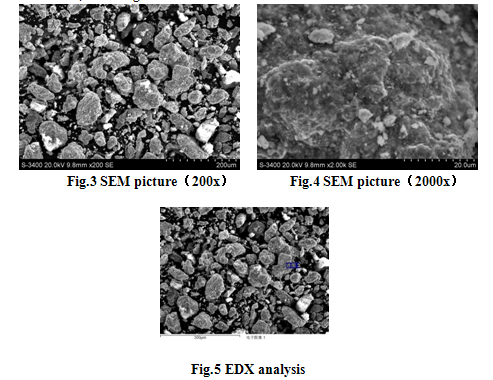

Car Bottom Furnace rapid reduction mechanism technology research
Wang Jianchun Wang Xiangyu Wang Chuanjie
(Tangshan Outstanding Science & Technology Co., Ltd R&D center)
Abstract: It is significant of the study rapid reduction of car bottom furnace process and mechanism for large-scale development and utilization of domestic low-grade ore. Through the systematic research of the domestic low-grade Oolitic reduction process and mechanism, and through the analysis of the samples of XRD, SEM and EDX, the test results show that the reduction temperature is at 1150 ℃, reducing time is 100min, adding a certain proportion of the additive material with thickness volumes of 30mm, mineral particle size of 1-3mm under reducing conditions, we have made better results of the low-grade mineral depth reduction and efficient separation.
Introduction
The motivations of the car bottom furnace rapid reduction process are:
- China is rich in iron ore resources, but the main characteristics of the iron ore is "poor", "small", and “mixed", with an average iron grade of 32%, the world average grade is 43%. Among them 97% of the iron ore needed beneficiation process, and Refractory Red Iron is in large proportion (about 20.8 percent of iron ore reserves), it is subject to the application of advanced technology and equipment to restore and processing.
- China's solid waste disposal of steel industry is in urgent and need advanced and applicable technology and equipment.
- Non-ferrous metal refining and waste reduction treatment: laterite nickel ore, nickel molten slag, copper smelting slag, high zinc and iron dust and mud.
- using high-grade magnetite powder steelmaking DRI also requires the application of advanced technology and equipment.
- A large number of low-grade refractory ore reduction and treatment.
(Such as oolitic hematite, limonite, siderite, mirror iron ore and vanadium-titanium magnetite)
It is in this application background, we make the research and development of the car bottom furnace DRI rapid reduction process. the key equipment in the process is the car bottom furnace rapid reduction, which besides has its own unique advantages, it is also fully absorbed the tunnel kiln and rotary hearth furnace strengths, its most important feature is the ability to ensure the rapid reduction of the mineral in a reducing atmosphere, and high temperature reduction can be achieved without oxidation.
On the basis of numerous small-scale test , We has already invested nearly 2 million yuan to build up a semi-industrial pilot plant and a semi-industrial tests of the vehicle with the reduction furnace, it is introduced to a domestic low-grade steel company’s Oolitic hematite system of ore reduction process and mechanism of the test, with samples of XRD, SEM and EDX analysis, test results show that the reduction temperature is 1150 ℃, reducing time is 100min, adding a certain percentage of additive material thickness of 30mm, mineral particle size is 1-3mm under reducing conditions, get low-grade mineral depth reduction and efficient separation a better results.
1 Experimental research methods of process and mechanism
High Phosphorus Oolitic mineral raw materials are used in the tests, and its total-iron TFe% = 47, which is a typical low-grade refractory ore dressing, two kinds particle size of 200 mesh and ≤3mm .
The reducing agent was used in the test as anthracite, which had a particle size of -100 mesh, fixed carbon content is 63%, ash content is 20 to 21%, volatile content is 6 to 12%, a sulfur content is 0.2% to 0.3%. Desulfurizer was adopted with limestone; In addition the experiment also added a small amount of additives.
2 Results and mechanism analysis
During the experiment using inner carbon method, through the test ,we get the results that under the best conditions with the use of inner carbon 30%, the temperature reducing process was at 1150 ℃, the reducing time is 100min, adding a small amount of additive material with the thickness of 30mm, mineral particle size is 1-3mm, the resulting reduction of the sample after magnetic separation with its total iron the TFe% was up to 84.15.
2.1 Car bottom furnace preheating section reaction mechanism changes
Preheating zone temperature is generally below 1000 ℃, the material reaction changes include evaporation of moisture and hydrates; escape of reducing volatiles; the decomposition of desulfurizer (limestone). Temperature 100 ~ 110 ℃, the substantial evaporation of adsorbed water to escape; 200 ℃, the crystallization water begins to decompose, the crystallization water to escape from the mineral generally did not exceed more than 600 ℃.
If the carbon-containing metal material with the high water content, in the warm-reduction process, it will consume large amounts of heat and CO and carbon, which is detrimental to the reduction process, therefore, the carbon-containing metal materials should be treated for in strict control of its water content

When the temperatures of carbon-containing metal material is heated to 400 ℃, reducing volatiles emitted a strong start, it can only end up until it is at 800 ~ 1000 ℃. In addition the desulfurizer(limestone)will decompose at the temperature.

The above reaction is an endothermic reaction, it will absorb large amounts of heat during the process of calcium carbonate decomposition, the temperature of calcium carbonate decomposition is about 750 ℃, when the temperature reaches 910 ℃,the violent decomposition occurs. The reaction among the decomposition products CaO and minerals and the reducing agent is to form a stable sulfide CaS, so as to achieve the purpose of desulfurization. And because the decomposition of calcium carbonate will emit a lot of CO2 gas, In the process of evolution of CO2 carbon-containing metal material, it leaves countless tiny pores, which lay the foundation for the reduction process of the carbon contained material in the next step.
2.2 Car bottom furnace reduction section material reaction mechanism
The temperature of Car bottom furnace reduction can generally be controlled between 1100 ~ 1400 ℃, according to the different kinds of minerals, which can be controlled in different temperature ranges. And vehicle furnace reduction zone can ensure that can keep on a reducing atmosphere, which is unique characteristic that different from the other furnace.
The changes of carbon with metal material are mainly reduction process, Because it is in the way with the use of inner carbon, carbon can be regarded as uniform distribution, when carbon-containing metal material is heated to a certain temperature, numerous carbon particles react with the iron oxide, Since the preheating zone in substantially reducing, the volatiles have escaped completely, only left the fixed carbon in direct contact with the iron oxide. Iron oxide is direct contact with carbon reduction, which was known as "solid - solid direct reduction." Reaction scheme is shown below.

During the preheating zone process, the decomposition of calcium carbonate generated a lot of CO2, and CO2 with the carbon gasification reaction at high temperature will happen, which generates CO, reaction is as follows.

The gasification reaction of CO can be restored through the bore contacting with the iron oxides, reaction formula is shown as follow

Reaction formula (6) and reaction formula (7) combined overall reaction results were obtained

The result of its direct reduction by means of reducing carbon gas generated by the gasification reaction, the iron oxide is direct contact with the CO reduction, which is known as the "gas - solid direct reduction." Figure 1 is a model diagram of iron oxide reduction unit.

1.3 The material changes at car bottom furnace cooling section
After the reduction, the sponge iron was get into the cooling stage, in this process, the traditional reduction process will exist the problem in the sponge iron re-oxide again. But as for car bottom furnace, owing to the adoption of patent technology, which basically does not exist this kind of risk, the reduction zone and cooling zone in this furnace are all reducing atmosphere, under the protection of cooling zone reducing atmosphere, the DRI will not happen oxidation phenomenon again. As long as the DRI in cooling zone cooled to below 500 ℃, the product will not happen oxidation again.
1.4 sample of XRD, SEM and EDX analysis
In order to make further analysis of the reduction sample from the microstructure and phase composition, we carry on analysis of the sample by XRD, SEM and EDX analysis.
Figure 2 for test ore samples under the condition of optimum process after test of XRD analysis. From the map we can see that the phase in the sample after test is mainly Fe, Fe3O4, and part of C. From the peak we can see that the Fe content in the samples is strong in large proportion. It also implies that after car furnace reduction ore samples, the hematite had changed into metallic iron and Fe3O4, and the metallization rate is quite high.
Figures 3 and 4 was shown SEM images that after restored samples of grinding magnetic separation ,we can be seen from the picture, sample particle size distribution was Relatively uniform and evener, Particle grain size was below 200 mesh.
Figure 5 showed the sample of EDX analysis diagram. The points in the graph element analysis results are shown in table 1
Table 1 is the EDX analysis result, which can be seen from the table, the main elements were Fe, C, O, as well as small amounts of other elements.

3 Conclusions
(1) The test is aimed at the low grade high phosphorus oolitic hematite, studied and developed a set of feasible reduction process, the reduction temperature is 1150 ℃, reduction time is 100 minutes, granularity for 1-3 mm, inside carbon with 30%, a moderate amount of adding additives, under the condition of material layer thickness of 30 mm, which can achieve deeply reduction and efficient separation. Using TFe % = 47 oolitic hematite can get the sponge iron TFe % = 88
(2) The test proved that the car bottom furnace rapid reduction process for the comprehensive development and utilization of low-grade high phosphorus oolitic hematite has some reference for other low-grade refractory ore dressing reduction.
(3) According to the analysis and explain of the sample XRD, SEM and EDX, it shows that this type of process technology products can achieve certain product standards, after well improvement, the process can achieve large-scale industrial production.
(This article was published in "China's steel industry," 2010, No. 5)